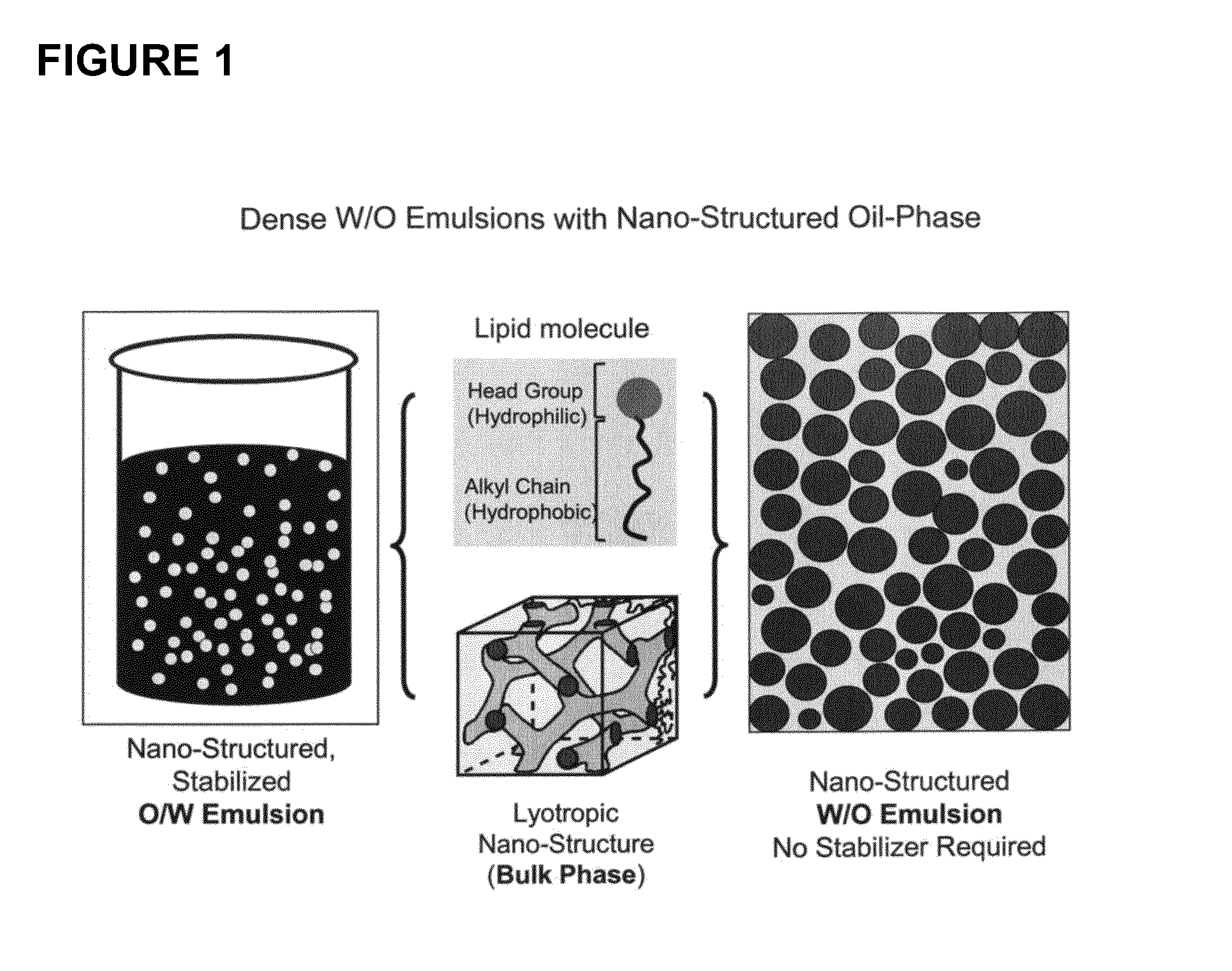Water-in-oil emulsions and methods for their preparation
a technology of water-in-oil emulsions and emulsions, which is applied in the field of water-in-oil emulsions, can solve the problems of affecting some intended applications, affecting the stability of water-in-oil emulsions,
- Summary
- Abstract
- Description
- Claims
- Application Information
AI Technical Summary
Benefits of technology
Problems solved by technology
Method used
Image
Examples
example 1
Formation of a 50% Water-in-Oil Emulsion Based on a Micellar-Cubic Lipid Phase
[0099]16 g “oil phase” (hydrophobic phase) were prepared by mixing at about 30° C. This oil phase consisted of 4.48 g glycerol monoolein (GMO), 6.72 g diglycerol monoolein (DGMO), 4.67 g almond oil, and 0.13 g tee-tree oil.
[0100]This oil phase was then mixed with the water phase, containing 1.2% κ-carrageenan, in a volume ratio of 1:1 in the premixing chamber of a shear device at 20,000 rpm and sheared with a shear rate of 31,410 s−1 at a constant temperature of 80° C. The resulting emulsion was immediately cooled to a temperature below 40° C. in a flow-through cooler to ensure the formation of the micellar cubic phase.
example 2
Formation of a 67% Water-in-Oil Emulsion Based on a Micellar-Cubic Lipid Phase
[0101]11 g “oil phase” (hydrophobic phase) were prepared by mixing at about 30° C. This oil phase consisted of 3.08 g GMO, 4.62 g DGMO, 1.65 g almond oil, and 1.65 g sunflower oil.
[0102]This oilphase was then mixed with the water phase, containing 1.2% κ-carrageenan, in a volume ratio of 1:2 in the premixing chamber of a shear device at 20,000 rpm and sheared with a shear rate of 31,410 s−1 at a constant temperature of 80° C. The resulting emulsion was immediately cooled to a temperature below 40° C. in a flow-through cooler to ensure the formation of the micellar cubic phase.
example 3
Formation of a 50% Water-in-Oil Emulsion Based on a Micellar-Cubic Lipid Phase
[0103]160 g “oil phase” (hydrophobic phase) were prepared by mixing at about 30° C. This oil phase consisted of 44.8 g GMO, 67.2 g DGMO, and 48 g evening primerose oil.
[0104]This oil phase was then mixed with the water phase, containing 1.2% κ-carrageenan, in a volume ratio of 1:1 in the premixing chamber at 20,000 rpm and sheared with a shear rate of 31.410 s−1 at a constant temperature of 90° C. The resulting emulsion was immediately cooled to a temperature below 40° C. in a flow-through cooler to guarantee the formation of the micellar cubic phase (for SAXS data of this sample see FIG. 7).
PUM
| Property | Measurement | Unit |
|---|---|---|
| Temperature | aaaaa | aaaaa |
| Temperature | aaaaa | aaaaa |
| Length | aaaaa | aaaaa |
Abstract
Description
Claims
Application Information
 Login to View More
Login to View More - R&D
- Intellectual Property
- Life Sciences
- Materials
- Tech Scout
- Unparalleled Data Quality
- Higher Quality Content
- 60% Fewer Hallucinations
Browse by: Latest US Patents, China's latest patents, Technical Efficacy Thesaurus, Application Domain, Technology Topic, Popular Technical Reports.
© 2025 PatSnap. All rights reserved.Legal|Privacy policy|Modern Slavery Act Transparency Statement|Sitemap|About US| Contact US: help@patsnap.com



